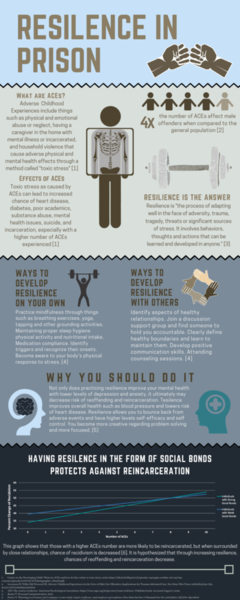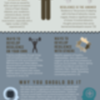Resilience for the forgotten is a rehabilitation program for the imprisoned. The Prisoner ACE Survey done in Wales in 2018, found that higher ACE scores are significantly more common in prisoners, particularly violent offenders when compared to the general population1. Additionally, this population with higher ACE scores are more likely to re-offend within three years of release, thereby contributing to recidivism rates, which are currently ranging from 22% to 58%, depending on the state1,2.
A common mantra often spoken in correctional institutes is “hurt people hurt people.” This phrase essentially means that individuals improperly dealing with their own trauma are unable to recognize their triggers and lash out and respond in inappropriate ways, often hurting others. This creates victims of violent attacks, whether it be random, domestic, or anywhere in between. While it is incredibly important to treat and care for the victims, it is also crucial to treat and reform the perpetrators; otherwise, the cycle of violence continues to exist. Additionally, individuals in prison may currently be treated in such a way that retraumatizes them, thereby inhibiting any chance of reform. This program calls for a reform of the justice system and correctional facilities to incorporate trauma-informed practices along with resilience-building programs for individuals so that they may be able to return to society as a contributing and non-threatening member. This campaign also asks for funding and awareness so studies can be completed to determine what types of resiliency programs work and how efficacious they are in preventing recidivism.
The campaign consists of three components: an infographic, a trifold brochure, and a podcast. The infographic is designed as a poster and is meant to be posted in correctional institutions where incarcerated individuals can see it. It includes vital statistics on ACEs, what they are and their prevalence, as well as an introduction to the concept and benefits of resilience. The infographic recommends mindfulness exercises as well as encourages the individuals to discuss concerns with a counselor or in a group therapy session to promote and practice healthy relationships. Ideally, it is also to be used to stimulate interest in the potential for resiliency programs beginning in prisons. It utilizes a social cognitive approach as it strives to have offenders recognize that the power of resilience is in their hands, increasing self-efficacy. The second component, the brochure, will be given to key stakeholders and policymakers, introducing them to the topic of ACEs in prison and why it is a public health concern. It includes details such as the cost of prisons and prison ACE statistics. It also poses the idea that through monetary support and policy, this can not only benefit the individual offender but the broader population. Finally, the third component is meant to generate interest in the topic of ACEs. It is a recorded interview with a licensed clinical social worker with extensive interaction with emotionally disturbed children, some of which who have been incarcerated, and individuals with PTSD. This interview does not solely cover the topic of ACEs in prison, but brushes on the topic and strives to be a starting block for people interested in the topic and to get the community involved.
I would appreciate any feedback you may have to offer!
Savanah Mueller, BS, CCMA, CPT, CPhT
Master of Public Health Candidate
University of Florida

- Ford K, Barton ER, Newbury A, et al. The Prisoner ACE Survey. Wales; 2019. www.nationalarchives.gov.uk/do...t-licence/version/3/. Accessed August 5, 2019.
- The Sentencing Project. Trends in U.S. Corrections. Washington, D.C; 2018. https://sentencingproject.org/...n-US-Corrections.pdf. Accessed August 5, 2019


Comments (0)